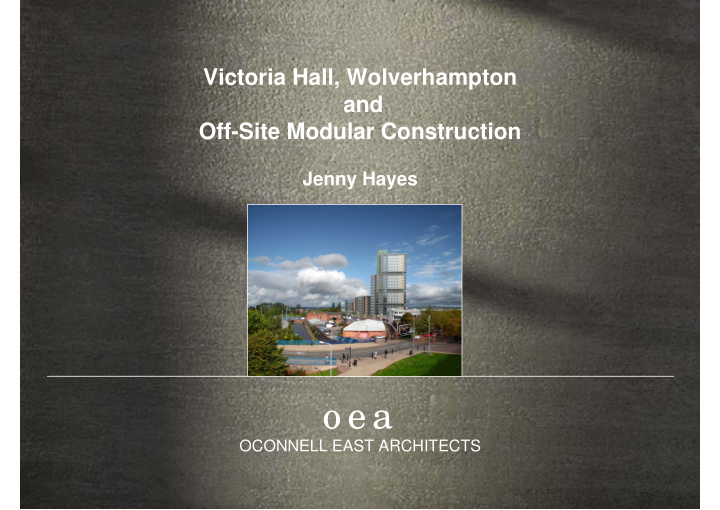



Victoria Hall, Wolverhampton and Off-Site Modular Construction Jenny Hayes o e a OCONNELL EAST ARCHITECTS o e a OCONNELL EAST ARCHITECTS
Victoria Hall, Manchester Low Rise Low Budget - £5.5M Traditional Loadbearing Construction Low Risk Relatively High Returns o e a OCONNELL EAST ARCHITECTS
VHL Wolverhampton - Site o e a OCONNELL EAST ARCHITECTS
OCONNELL EAST ARCHITECTS Site - Looking North o e a
OCONNELL EAST ARCHITECTS Site Surroundings o e a
Existing Site – Analysis and Constraints o e a OCONNELL EAST ARCHITECTS
Approved Scheme – By Day o e a OCONNELL EAST ARCHITECTS
Approved Scheme - By Night o e a OCONNELL EAST ARCHITECTS
Approved Scheme – East Elevation o e a OCONNELL EAST ARCHITECTS
Approved Scheme – South Elevation o e a OCONNELL EAST ARCHITECTS
OCONNELL EAST ARCHITECTS Distant Views o e a
Blocks B & C - Material Treatment Blue engineering brick at ground and first floor of all blocks White acrylic render to upper floors of Blocks B, C & D with projecting frame detail linking bedroom windows. Lounge bay window projections of dark grey metallic metal cladding incorporating coloured aluminium panels Green metallic composite aluminium cladding Fully glazed management suite and common rooms to give street presence and internal activity at ground and first floor levels o e a OCONNELL EAST ARCHITECTS
Block A – Articulation and Materials Blue engineering brick at ground and first floor Silver metallic and dark grey metal cladding to tower with horizontal joints. Replicated lounge bay window projections of dark grey metallic metal cladding incorporating coloured aluminium panels used on Blocks B & C Cantilevered elements to SE prominent corner Glazed lift shafts and stair core landings o e a OCONNELL EAST ARCHITECTS
Conversion to Modular Construction o e a OCONNELL EAST ARCHITECTS o e a OCONNELL EAST ARCHITECTS
Fleming Proposals Early Completion 2009 – 1 year early Reduced floor to floor height from 3075mm to 2800mm Fundamental change in overall super structure and foundation design Provision of an additional 23 study rooms – primarily to provide structural continuity but gave benefit to Client of additional revenue Blocks B & C Relocation/configuration of ground and first floor common room/multi-use spaces and refuse stores Incorporation of 1m deep transfer structures at 1st and 2nd floor levels Investigate alternative cladding materials for Block A Block A – reconfigured floor plate due to the south-eastern cantilever structures and reduced core structure o e a OCONNELL EAST ARCHITECTS
Fleming Proposals – Ground Level o e a OCONNELL EAST ARCHITECTS
Fleming Proposals – Podium Level o e a OCONNELL EAST ARCHITECTS
Block A – Amendments to Elevational Treatment o e a OCONNELL EAST ARCHITECTS
Amended Scheme – South Elevation o e a OCONNELL EAST ARCHITECTS
Amended Scheme – East Elevation o e a OCONNELL EAST ARCHITECTS
OCONNELL EAST ARCHITECTS Site Progress – Block C o e a
OCONNELL EAST ARCHITECTS Site Progress – Block A o e a
Internal Finishes – Show Flat o e a OCONNELL EAST ARCHITECTS
OCONNELL EAST ARCHITECTS Completion August 2009 o e a
Off-Site Construction - Advantages Off-site construction allows the build process to run concurrently can equate to as much as 60% reduction in programme Off-site construction offers improved building quality due to the controlled construction environment i.e. factory finish and turn-key solution Cost certainty for Client Reduced waste (off cuts, packaging etc) – new legislation in the UK forces construction clients, designers and contractors to adopt a more sustainable approach to waste. Off-site construction facilities are enclosed and secure protecting against weather damage and delays as well as theft. Permanent, long term employment for skilled labour both within the factory and engineers on site. Improved Fire/Acoustic performance (effectively two walls between all rooms with a cavity) Improved Thermal Efficiency Safety - Reduced number of workers/man hours on site - Workers have a reduced number of tasks / hazards - System building allows detailed analysis of risks at each stage Less noise, dust and general disturbance Fewer commercial vehicle movements o e a OCONNELL EAST ARCHITECTS
Off-Site Construction - Disadvantages Economically efficient for repetitive floor plates only Most off-site modular systems are limited to low-rise due to structural stability of modules Modules are limited in size by transport legislation and width of delivery vehicles Preferred sizes (but larger sizes /heights are common) - Width 4.0m outer face of floor steel - Length 10.6m outer face of floor steel - Height 2.8m floor to floor Design freeze required early in the project. VMS System is 18 weeks prior to scheduled delivery on site. Size of crane required to lift modules may not be cost effective with smaller quantities Transportation can be costly if site is remote, significant distance from factory and if loads are wide No flexibility or option for future adaptation o e a OCONNELL EAST ARCHITECTS
Off-Site Construction: Limitations Block A To comply with the approved scheme cantilever elements were retained to the SE elevation. The internal room configuration was adjusted to provide some structural continuity together through the modules. Barratt Mahony designed an additional structural H-frame to provide support to the underside of cantilevers. Introduction of non-standard floor plates within modular construction can be costly. o e a OCONNELL EAST ARCHITECTS
Points to consider: Are traditional and modular construction methods really that different? Did working with an off-site supply chain help or constrain design and flair on the project? What are the critical success factors for architecture and designer working with offsite? Would we recommend off-site? Limitations of off-site construction? o e a OCONNELL EAST ARCHITECTS
Recommend
More recommend